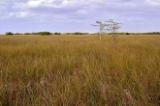 © Steve Vaughn/Panoramic Images (Florida Title Image Large)
© Steve Vaughn/Panoramic Images (Florida Title Image Large)

Florida Everglades
The Everglades – Florida’s famed and iconic subtropical ecosystem – occupies much of the state’s southern peninsula. The Everglades ecosystem is a diverse, interconnected mosaic of habitats unlike anywhere on the North American continent. Its wetlands act as a water treatment and water storage facility, absorbing and storing millions of gallons of water, recharging aquifers, enriching estuaries and providing needed flow to streams and rivers. Wetlands are biological factories, producing oxygen and contributing critical elements to a complex food chain. The Everglades’ wetlands are defense shields that buffer against damaging storms, tidal surges and floods. Yet millions of Floridians go about their daily business often unaware of the complex and fragile aquatic system that sustains them.
Today, even in it's diminished form, Florida’s “river of grass” remains a haven for a rich abundance of plant and animal life, including Florida panthers, one of the state’s rarest species.
Key characteristics that historically defined the Everglades system include its large size, the way in which water flowed across the land, and its diverse habitats. As recently as the late 1800s, the Everglades spanned an impressive 8.9 million acres. Except by looking at a map, it is difficult for most people to imagine an area this large or to understand the complex workings of this massive ecosystem. Throughout its history, the Everglades accommodated animals with large feeding ranges and special habitats. Its wetlands produced an abundance of aquatic life, which, in turn, supported larger animals. The Everglades ecosystem was large enough to sustain and recover from the impacts of repeated natural disturbances such as fires and hurricanes.
Much of South Florida’s summertime rainfall collected in the broad, shallow, gently sloping valley that is the Everglades. Historically, rainwater from the Kissimmee valley flowed south to Lake Okeechobee, occasionally overflowing the lake’s southern shoreline. This water would continue on a slow journey southward through the Everglades, eventually emptying into Florida Bay. This slow movement – estimated at one-quarter mile per day – essentially served to store the water and ensure that flows continued well into the dry winter season. Some of this stored water seeped into underground reservoirs, replenishing Florida’s vast system of aquifers.
In the southern reaches of peninsular Florida, temperate and subtropical zones merge in the Everglades to form one of the largest, most complex and biologically rich ecosystems in North America. The Kissimmee-Okeechobee-Everglades ecosystem includes more than 12 natural plant communities, hundreds of distinctive habitats, and thousands of interconnected ecological niches.
Development in south Florida over the past 100 years altered this vibrant ecosystem, reducing its original area by roughly 50 percent. The great sheets of water that once flowed lazily across the Everglades' original expanse are now diverted to a network of canals. The loss of so much wetland area has significantly eroded biological diversity, lowered survival rates of wide-ranging vertebrate species, and reduced populations of many bird species to the point that some are now threatened with extinction.
Fortunately, there is still hope for the Everglades ecosystem. A historic partnership aimed at Everglades restoration was forged among federal, state, local and tribal leaders in the 1990s. The Comprehensive Everglades Restoration Plan (CERP) outlines a long-term series of water system and environmental improvements aimed at restoring most of the pre-drainage flow to Everglades National Park and promoting the regions’ natural habitats and its plant and animal diversity.
Explore the Everglades:
Everglades National Park
The Everglades can be a challenge to explore—it’s big, it’s wet, it’s difficult to get around. Probably the best way to see the Everglades is a trip to Everglades National Park. There are many ranger-led activities and several maintained trails: two notable trails are the Gumbo Limbo trail and the Anhinga Trail. The best way to get a feeling for Everglades ecology is an off-trail hike with a ranger—and plan to get your feet wet.
The Comprehensive Everglades Restoration Plan
The Comprehensive Everglades Restoration Plan (CERP) provides a framework and guide to restore, protect and preserve the water resources of central and southern Florida, including the Everglades. The CERP plan, covering 16 counties and an area of more than 18,000 square miles, centers on an update of the Central & Southern Florida Project also known as the “Restudy.”
The Purchase of U.S. Sugar for Everglades Restoration
The state of Florida will purchase vast tracts of farm lands around Lake Okeechobee as part of the Comprehensive Everglades Restoration Plan. The $1.34 billion land-only agreement is one of the largest environmental land acquisitions in American history. The South Florida Water Management District approved the deal in December 2008.
Friends of the Everglades
A grass-roots volunteer organization, Friends of the Everglades strives to protect and restore the Kissimmee-Okeechobee-Everglades ecosystem through education, outreach, and advocacy. This non-profit group also provides information on the Florida Everglades and offers ways to help protect this unique natural treasure.
Go Straight to Your State
Learn about conservation and open space in your state.





